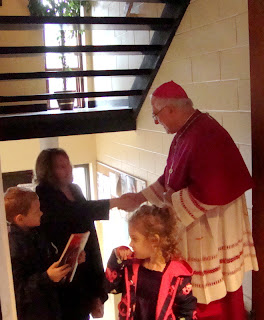Today the liturgy permits optional memorials of martyr saints, St. Wenceslaus or a new feast that of the Asian Martyrs.
St. Lawrence (Lorenzo) Ruiz was born in Manila of a Chinese father and a Filipino mother, both Christians. Thus he learned Chinese and Tagalog from them and Spanish from the Dominicans whom he served as altar boy and sacristan. He became a professional calligrapher, transcribing documents in beautiful penmanship. He was a full member of the Confraternity of the Holy Rosary under Dominican auspices. He married and had two sons and a daughter.
His life took an abrupt turn when he was accused of murder. Nothing further is known except the statement of two Dominicans that "he was sought by the authorities on account of a homicide to which he was present or which was attributed to him."
At that time three Dominican priests, Antonio Gonzalez, Guillermo Courtet and Miguel de Aozaraza, were about to sail to Japan in spite of a violent persecution there. With them was a Japanese priest, Vicente Shiwozuka de la Cruz, and a layman named Lazaro, a leper. Lorenzo, having taken asylum with them, was allowed to accompany them. But only when they were at sea did he learn that they were going to Japan.
They landed at Okinawa. Lorenzo could have gone on to Formosa, but, he reported, "I decided to stay with the Fathers, because the Spaniards would hang me there." In Japan they were soon found out, arrested and taken to Nagasaki. The site of wholesale bloodshed when the atomic bomb was dropped had known tragedy before. The 50,000 Catholics who once lived there were dispersed or killed by persecution.
They were subjected to an unspeakable kind of torture: After huge quantities of water were forced down their throats, they were made to lie down. Long boards were placed on their stomachs and guards then stepped on the ends of the boards, forcing the water to spurt violently from mouth, nose and ears.
The superior, Antonio, died after some days. Both the Japanese priest and Lazaro broke under torture, which included the insertion of bamboo needles under their fingernails. But both were brought back to courage by their companions.
In Lorenzo's moment of crisis, he asked the interpreter, "I would like to know if, by apostatizing, they will spare my life." The interpreter was noncommittal, but Lorenzo, in the ensuing hours, felt his faith grow strong. He became bold, even audacious, with his interrogators.
The five were put to death by being hanged upside down in pits. Boards fitted with semicircular holes were fitted around their waists and stones put on top to increase the pressure. They were tightly bound, to slow circulation and prevent a speedy death. They were allowed to hang for three days. By that time Lorenzo and Lazaro were dead. The three Dominican priests, still alive, were beheaded.
Pope John Paul II canonized these six and 10 others, Asians and Europeans, men and women, who spread the faith in the Philippines, Formosa and Japan. Lorenzo Ruiz is the first canonized Filipino martyr.
* * *
Grant us, we pray, Lord God, the same perseverance in serving you and our neighbour as your Martyrs St. Lawrence Ruiz and his companions, since those persecuted for the sake of righteousness are blessed in your Kingdom. Through our Lord.
* * * * * *
PASTORAL VISITATION TO ST. MONICA'S PARISH (NEPEAN)
On September 11-12, Father Muldoon, my Episcopal Vicar, and I began the Pastoral Visitation of St. Monica's faith community; it included on Wednesday, September 22 assemblies at St. Monica's and St. Andrew's elementary schools, meet-and-greet sessions at two seniors' residences and closed with a visit to the Holy Cross Sisters' convent. This latter time allowed us to speak about the forthcoming canonization of Brother Andre (who belonged to the male branch of their Holy Cross institute).
On Sunday evening, we completed the Visitation by holding cordial consultations with representatives of the Parish Council and other representative bodies, as well as with the Land Use committee.
So many pictures were taken and choosing from among them was difficult.
Herewith is an extensive selection of the many features of the Visitation that even included an inspection of Fr. Freely's garden and delightful meals in which we savoured some of vegetables harvested from it.





















Your Grace,
ReplyDeleteThank you for your excellent blog. It is always good to see what is happening with the good ministry that you are providing to the people of your diocese.
May I simply point out, with all due respect, that the bishop's mitre is never to be worn without being vested for Holy Mass. Wearing the mitre with choir dress is not appropriate unless the mozetta is removed and a cope and stole are being worn.
Respectfully submitted.
Time to get rid of that middle age stuff as well as fawning all over the Jesuits and deal with your Archdiocese/
ReplyDeleteWhile you're off in Ireland at a publicity stunt by the Vatican who'll look after Ottawa?